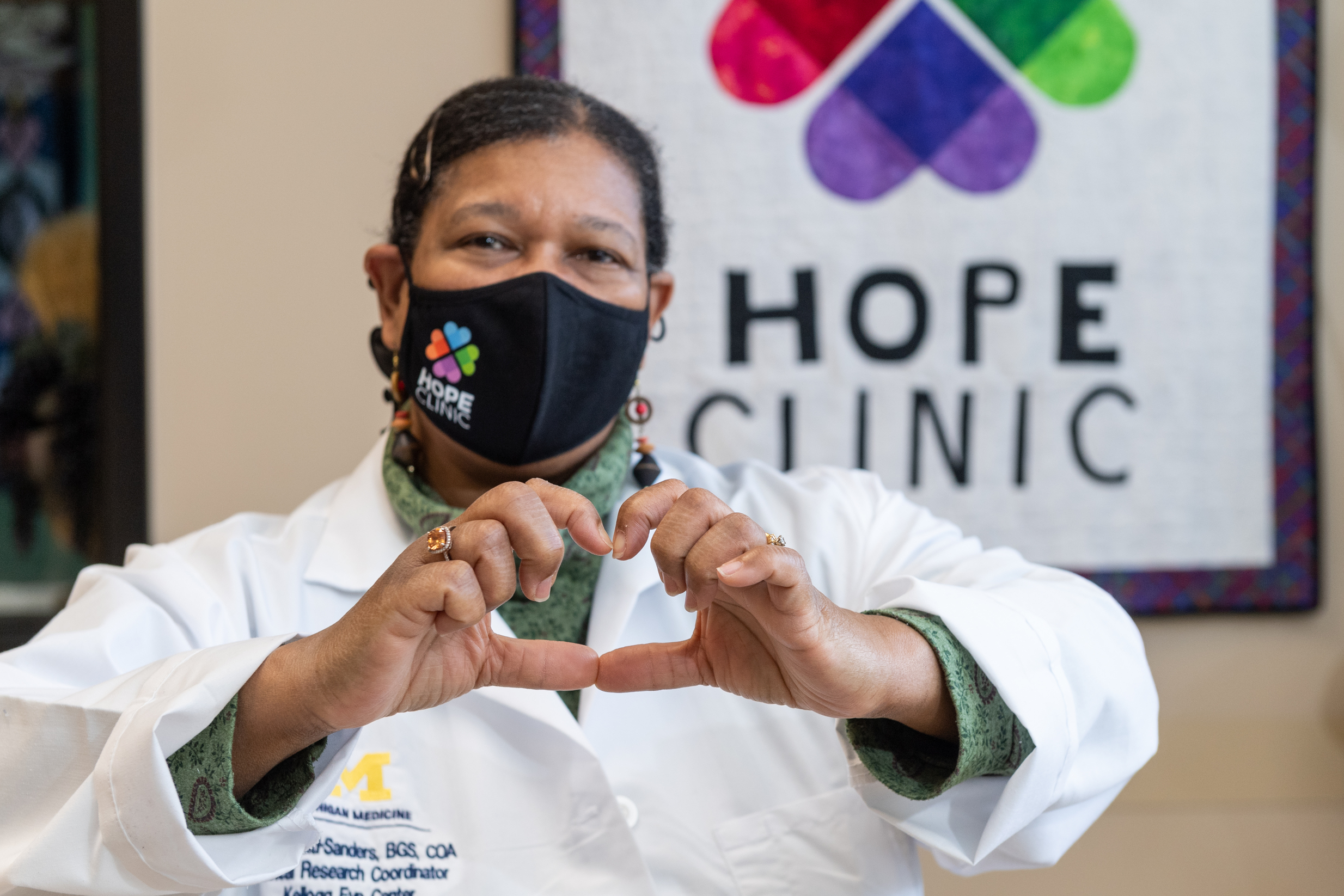
4 minute read
Telemedicine Intervention Improves Eye Health
Pictured above: Dr. Newman Casey and volunteers at a Saturday Hope Clinic
Improving the vision health of underserved populations has been a key focus at Kellogg. Those facing the greatest risk of vision loss from diseases like glaucoma and diabetic retinopathy tend to be the least likely to have access to an eye care provider. And far too many people suffer from poor vision because of a lack of access to basics like vision screening and affordable glasses.
An ambitious pilot intervention now being evaluated in two southeast Michigan communities is addressing these issues. Launched in 2019, MI SIGHT (Michigan Screening & Intervention for Glaucoma & Eye Health Through Telemedicine) is funded through 2024 by a grant from the Centers for Disease Control and Prevention (CDC).

The Kellogg team discusses patient care
Both clinical data and anecdotal evidence indicate that the program’s combination of telehealth and community-based medicine is an effective model to deliver screening and timely followup care to patients at elevated risk of vision loss from undetected or untreated eye disease or from just needing glasses.
Rich and Kathy Sistek learned about MI SIGHT soon after its launch through a neighborhood online forum. “There was a post about a new eyecare program in the area offering free vision exams and accepting new patients.” Kathy recalls. The Sisteks phoned and arranged back-to-back appointments at the Hope Clinic in nearby Ypsilanti.
Detailed intake interviews preceded their eye exams. “The technician, Londa, was wonderful,” says Rich. Although neither Rich nor Kathy screened positive for disease, they both left with updated glasses prescriptions to improve their vision. However, Kathy’s exam revealed a potential concern in one eye, which was resolved by the reviewing Kellogg ophthalmologist. They have since returned to the Hope Clinic for a scheduled follow-up exam, prompted by a text reminder. “Everyone was professional and respectful, and the whole experience was easy,” Kathy adds.
A Snapshot of Success
Preliminary data confirm that participants like the Sisteks value the program, and that the approach is effectively identifying and addressing vision issues:
90.7% of participants were highly satisfied with their screening visit
71% needed vision correction and ordered glasses through the program s
39% of participants needed follow-up with an ophthalmologist for further care
24.4% screened positive for glaucoma, three times the national average
7.3% screened positive for diabetic retinopathy, twice the national average

Londa Reid-Sanders
How MI SIGHT Works
Vision technicians are available in two familiar, trusted community clinics–the Hope Clinic, a free clinic in Ypsilanti, and the Hamilton Clinic, a federally qualified health clinic in Flint. The technicians perform tests to assess patient vision and eye health.
Patient information and eye screening data collected during exams are transmitted through the electronic medical record to an ophthalmologist at Kellogg who reviews and interprets the chart and imaging and creates a plan for follow-up care, if needed. Results and physician-directed care plans are transmitted back to the technicians, who educate patients about their diagnoses, help them obtain recommended follow-up, and dispense and fit low-cost glasses as appropriate. When a condition like glaucoma is diagnosed, the clinic’s staff is there to help the patient navigate follow-up appointments, insurance options and access to low- or no-cost treatment options.
“MI SIGHT is currently one of three CDC-funded programs delivering low-cost ophthalmic care in underserved communities around the country,” says Principal Investigator Paula Anne Newman-Casey, M.D., M.S., “We’re hoping it will serve as a roadmap for similar interventions in other areas.”

Megan Sabb with Dr. Newman-Casey at a MI SIGHT event
MI SIGHT also created an opportunity for undergraduate University of Michigan senior Megan Sabb , majoring in Molecular, Cellular and Developmental Biology and Spanish, to gain hands-on experience in community outreach and research. She volunteered for MI SIGHT through a community outreach class and continued on with an independent study in Dr. Newman-Casey’s lab.
To gauge response to the program, Sabb interviewed a representative sample of 40 MI SIGHT participants, 20 from each clinic, and transcribed and coded their responses. “The overall feedback was so positive, confirming that participants from these communities value the program, particularly the combination of affordable glasses and free eye health exams,” she says.
Sabb, who plans to apply to medical school, received the Fight for Sight Summer Student Fellowship Award for her role in MI SIGHT.

Dr. Amy Zhang examines Beth Priebe at Hope clinic










